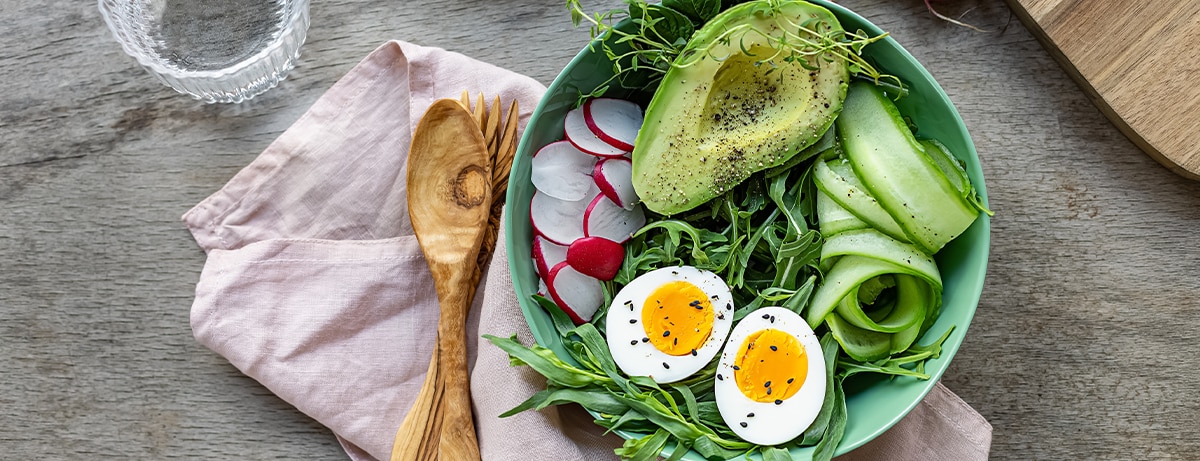15% off £35 OR 20% off £45
Code:FAVES
How to reduce the risk of osteoporosis

Protect your bones and prevent fractures! Discover expert tips to reduce your risk of osteoporosis. Learn simple lifestyle changes that can strengthen your skeleton and safeguard your future health.
Summary
1What is osteoporosis?
Osteoporosis is a long-term condition that occurs gradually. As bone mass and density decreases, your bones become weaker than they should be. This...
2Tips for preventing osteoporosis
Now you know a bit more about bone health and the causes of osteoporosis, let’s take a look at some of the steps you can take to help prevent it...
3The final say
Although genetics, gender, and age all play a role in your risk of developing osteoporosis, there are still elements in your control which can help...
Out of the countless broken bones in the UK every year, more than 500,000 are actually a direct result of a condition called osteoporosis.1
While you may have heard of this condition before, you probably don’t know how common it is.
Osteoporosis is estimated to affect more than three million people in the UK, the majority of which being women.2
There’s also no cure, but there are several things you can do to reduce your risk of developing it in the future. So if you’re keen to learn what these are, read on to find out.
What is osteoporosis?
Osteoporosis is a long-term condition that occurs gradually. As bone mass and density decreases, your bones become weaker than they should be. This weakness can lead to a range of problems, but by far the most common is fractures in the bone.3,4
While these broken bones are often the result of a fall from a standing height, or other blunt impact, in frail people with severe osteoporosis, something as simple as a forceful cough or sneeze can cause fractures to occur.3,4
What’s more, even though you can break any bone in your body, if you have osteoporosis, you’re much more likely to fracture bones in your wrist, pelvis, hip or the vertebrae of your spine.3,4
Osteoporosis: the silent disease
One of the most challenging aspects of osteoporosis is the lack of symptoms that it causes. It’s for this reason that the condition is often referred to as ‘the silent disease’.3
This effectively means that, even if you have osteoporosis, you almost certainly won’t know about it until you break a bone and a healthcare professional can properly diagnose you with the condition.3,4
Before we dive into some of the best ways to prevent osteoporosis, it’s important to first understand a bit more about your bones and why osteoporosis happens.
The first thing you need to know is that bones constantly evolve over the years.5,6 Every day, older bone in our bodies breaks down and becomes replaced by fresh, new bone – a process known as bone remodelling.5 It’s for this reason that we’re able to heal ourselves after a fracture or break.7
The rate of this bone growth is at its maximum during our childhood and teenage years, continuing until around the age of 30. This is when your bone strength and health is at its peak.2,5,6
Unfortunately, after the age of 30, our bodies start to break down bone more quickly than it’s able to make it. So if you’ve built up plenty of bone reserves in your younger years, you may be able to maintain bone strength for some time. But, if you haven’t, you could be at greater risk of osteoporosis.2,5,6
You could also be at greater risk if:2,8-13
- you’re born female
- you’re going through the menopause
- you have a family history of osteoporosis
- you drink excessive amounts of alcohol
- you have a low body weight
- you have, or have previously had, an eating disorder
- you currently smoke or have smoked in the past
Tips for preventing osteoporosis
Now you know a bit more about bone health and the causes of osteoporosis, let’s take a look at some of the steps you can take to help prevent it.
Eat calcium-rich foods
Calcium plays a vital role in your bone health. It’s the major component in bone, and also the place where 99% of the calcium in your body can be found.14,15
If you were strongly encouraged to drink milk during your childhood, this is because the calcium it contains helps your body to build strong, healthy bones.15,16
Unfortunately, our bodies are unable to produce calcium themselves and, instead, have to rely on getting it through the food and drinks that we consume. The recommended daily intake of calcium for adults aged 19 to 64 and over is 700mg.14,17 However, if you’re breastfeeding or have osteoporosis, you may need more calcium.15,17
The good news is that calcium can be found in a variety of foods other than milk. For example, you can boost your intake with:14
- green, leafy vegetables such as kale and cabbage
- dairy products, like milk, yoghurt and cheese
- wholegrains nuts and seeds
- dried fruits like apricots, figs, dates and prunes
- calcium-enriched plant milks
Increase your vitamin D intake
Vitamin D is just as important as calcium when it comes to supporting strong bones. This is because of its ability to help your body properly absorb calcium and support your bone growth.17,18,19
It’s thought that vitamin D in combination with calcium can increase bone mass density and potentially reduce the risk of developing osteoporosis in later years.20
Most of our vitamin D is made through our skin when we’re outside in daylight.21-23 But exposure to both indirect or direct sunlight isn’t always able to keep the levels where they should be. During the summer months (April to September) in the UK, sunlight plus a healthy balanced diet will usually be enough to meet most people’s vitamin D needs, but your body may not make enough vitamin D naturally during the winter months when there’s less sunlight or if you have darker skin.21,23
Fortunately, you can boost your vitamin D levels in a couple of ways. For example, you can find vitamin D in oily fish like salmon, mackerel and sardines, as well as egg yolks, red meat and liver. It’s also often added to some foods like cereals and spreads.19, 21,22
Vitamin D supplements can also be used to help boost those levels to prevent poor bone mineral density.21
Could drinking non-fermented teas help?
Well, emerging research from Korea and Taiwan has revealed that there could be a positive link between certain teas and bone health – more specifically, non-fermented teas such as green tea, yerba mate, and jasmine tea.24
The reason for this is that these teas contain flavonoids, catechins and polyphenols that have antioxidant effects.24
These effects have been suggested to potentially lower your risk of developing osteoporosis.25-27
Add vitamin C to your diet
Vitamin D isn’t the only nutrient that can help prevent osteoporosis – we’re also starting to see evidence that vitamin C could be beneficial too.27
Vitamin C plays an important role in the production of collagen in the bone, for example, helping improve bone mass density. It can also help eliminate free radicals (unstable chemicals produced during normal cell metabolism) which can negatively impact your bone health.28,29
Unfortunately, vitamin C can’t be stored in your body. But don’t fret, you can easily increase your vitamin C levels by adding some of these foods to your diet:28,30
- citrus fruits
- peppers
- chillies
- strawberries and blackcurrants
- rosehips
Stop smoking and limit alcohol consumption
Smoking isn’t only one of the biggest causes of death and illness in the UK but it has also been identified as a potential risk factor for developing osteoporosis.4,13
Researchers believe this could be because the nicotine you inhale when smoking may slow down the production of bone-forming cells, making it harder for your body to regenerate any bone that’s been lost. It can also make it harder for your body to absorb calcium.13,31
As highlighted by the NHS, there are countless benefits to stopping smoking – from improving your overall level of health to preserving your natural bone density.32
Research also suggests that excessive alcohol consumption can increase the risk of bone fractures caused by osteoporosis as well as having a generally negative effect on your bone and joint health.10,33,34
For this reason, NHS guidelines recommend drinking no more than 14 units of alcohol per week, spread across three days or more. This is approximately the same as having six medium glasses of wine or six pints of 4% beer.35
Get regular exercise
It’ll come as no surprise that exercise is recommended for improving your overall health and wellbeing.36
However, the NHS particularly recommends bone-strengthening exercises like walking and running, and muscle-strengthening exercises using your own body weight, such as squats and lunges, for helping to build bone mass.36,37,38
During one Australian study, post-menopausal women with low bone mass saw an increase in bone density after following a specific weight-bearing exercise regime just twice a week for 30 minutes.39
Some other effective exercises that you could consider include:37,40
- zumba and aqua zumba
- skipping
- tennis
- resistance training
The final say
Although genetics, gender, and age all play a role in your risk of developing osteoporosis, there are still elements in your control which can help protect you against this condition.
By understanding how osteoporosis occurs and making positive lifestyle changes, you could reduce your risk of developing osteoporosis and stay stronger, and more mobile for longer.
However, if you’re concerned about osteoporosis and would like to receive personalised advice, consult your GP. They’ll be able to answer any questions you may have and help identify your overall risk.
While we strive for accuracy and balance, please be aware that this article may discuss products available for purchase through Holland & Barrett. Consult a healthcare professional before making any health-related decisions.
- Age UK. Osteoporosis [Internet]. [cited 2024 Mar 11]. Available from: https://www.ageuk.org.uk/information-advice/health-wellbeing/conditions-illnesses/osteoporosis/.
- The Royal Osteoporosis Society. Women’s Health Strategy needs to go big on osteoporosis emergency affecting one in two women over 50 [Internet]. [cited 2024 Mar 11]. Available from: https://theros.org.uk/latest-news/women-s-health-strategy-needs-to-go-big-on-osteoporosis-emergency-affecting-one-in-two-women-over-50/.
- NIAMS. Osteoporosis [Internet]. National Institute of Arthritis and Musculoskeletal and Skin Diseases. 2017 [cited 2024 May 14]. Available from: https://www.niams.nih.gov/health-topics/osteoporosis
- NHS. Osteoporosis: Overview [Internet]. [cited 2024 Mar 11]. Available from: https://www.nhs.uk/conditions/osteoporosis/.
- Levine MA. Assessing bone health in children and adolescents. Indian journal of endocrinology and metabolism [Internet]. 2012 Jan 1 [cited 2024 May 14];16(8):205–5. Available from: https://www.ncbi.nlm.nih.gov/pmc/articles/PMC3603027/
- Duren DL, Maja Seselj, Froehle AW, Nahhas RW, Sherwood RJ. Skeletal growth and the changing genetic landscape during childhood and adulthood. American journal of physical anthropology [Internet]. 2012 Dec 20 [cited 2024 May 14];150(1):48–57. Available from: https://www.ncbi.nlm.nih.gov/pmc/articles/PMC3539213/
- Rowe, P., et al. ‘Physiology, Bone Remodeling’. StatPearls, StatPearls Publishing, 2024. http://www.ncbi.nlm.nih.gov/books/NBK499863/.
- NHS Choices. Causes - Osteoporosis [Internet]. 2024 [cited 2024 May 14]. Available from: https://www.nhs.uk/conditions/osteoporosis/causes/
- Bijelic, R., et al. ‘The Influence of Non-Preventable Risk Factors on the Development of Osteoporosis in Postmenopausal Women’. Materia Socio-Medica, 2019;31(1):62–65. https://doi.org/10.5455/msm.2019.31.62-65.
- Godos, J., et al. ‘Alcohol Consumption, Bone Mineral Density, and Risk of Osteoporotic Fractures: A Dose–Response Meta-Analysis’. International Journal of Environmental Research and Public Health, 2022;19(3):1515. https://doi.org/10.3390/ijerph19031515.
- Lee, JH., et al. ‘Optimal Body Mass Index for Minimizing the Risk for Osteoporosis and Type 2 Diabetes’. The Korean Journal of Internal Medicine, 2020;35(6):1432–42. https://doi.org/10.3904/kjim.2018.223.
- The Royal Osteoporosis Society. What is anorexia [Internet]. [cited 2024 Mar 11]. Available from: https://theros.org.uk/information-and-support/osteoporosis/causes/anorexia/
- Al-Bashaireh, A., et al. ‘The Effect of Tobacco Smoking on Bone Mass: An Overview of Pathophysiologic Mechanisms’. Journal of Osteoporosis, 2018;2018:1206235. https://www.ncbi.nlm.nih.gov/pmc/articles/PMC6304634/.
- NHS Choices. Calcium - Vitamins and minerals [Internet]. 2024 [cited 2024 May 14]. Available from: https://www.nhs.uk/conditions/vitamins-and-minerals/calcium/
- The Royal Osteoporosis Society. Calcium [Internet]. [cited 2024 Mar 11]. Available from: https://theros.org.uk/information-and-support/bone-health/nutrition-for-bones/calcium/
- Office of Dietary Supplements - Calcium [Internet]. Nih.gov. 2023 [cited 2024 May 14]. Available from: https://ods.od.nih.gov/factsheets/Calcium-Consumer/
- NHS. Osteoporosis Treatment [Internet]. [cited 2024 Mar 11]. Available from: https://www.nhs.uk/conditions/osteoporosis/treatment/
- Alicja Ewa Ratajczak, Zawada A, Anna Maria Rychter, Agnieszka Dobrowolska, Iwona Krela-Kaźmierczak. Milk and Dairy Products: Good or Bad for Human Bone? Practical Dietary Recommendations for the Prevention and Management of Osteoporosis. Nutrients [Internet]. 2021 Apr 17 [cited 2024 May 14];13(4):1329–9. Available from: https://www.ncbi.nlm.nih.gov/pmc/articles/PMC8072827/
- Office of Dietary Supplements - Vitamin D [Internet]. Nih.gov. 2015 [cited 2024 May 14]. Available from: https://ods.od.nih.gov/factsheets/VitaminD-HealthProfessional/
- Gavriela Voulgaridou, Sousana Papadopoulou, Paraskevi Detopoulou, Despoina Tsoumana, Constantinos Giaginis, Foivi Kondyli, et al. Vitamin D and Calcium in Osteoporosis, and the Role of Bone Turnover Markers: A Narrative Review of Recent Data from RCTs. Diseases [Internet]. 2023 Feb 8 [cited 2024 May 14];11(1):29–9. Available from: https://www.ncbi.nlm.nih.gov/pmc/articles/PMC9944083/
- NHS Choices. Vitamin D - Vitamins and minerals [Internet]. 2024 [cited 2024 May 14]. Available from: https://www.nhs.uk/conditions/vitamins-and-minerals/vitamin-d/
- Chen LR, Wen YT, Kuo CL, Chen KH. Calcium and Vitamin D Supplementation on Bone Health: Current Evidence and Recommendations. International journal of gerontology [Internet]. 2014 Dec 1 [cited 2024 May 14];8(4):183–8. Available from: https://www.sciencedirect.com/science/article/pii/S1873959814000891
- The British Heart Foundation. Heart Matter [Internet]. [cited 2024 Mar 11]. Available from: https://www.bhf.org.uk/informationsupport/heart-matters-magazine/nutrition/ask-the-expert/foods-high-in-vitamin-d
- Lee, D., et al. ‘Relationship between Regular Green Tea Intake and Osteoporosis in Korean Postmenopausal Women: A Nationwide Study’. Nutrients, 2021;14(1):87. https://doi.org/10.3390/nu14010087.
- Marcucci, G., et al. ‘Oxidative Stress and Natural Antioxidants in Osteoporosis: Novel Preventive and Therapeutic Approaches’. Antioxidants, 2023;12(2):373. https://doi.org/10.3390/antiox12020373.
- Hsu CL, Huang WL, Chen HH, Jerry Cheng-Yen Lai. Non‐fermented tea consumption protects against osteoporosis among Chinese male elders using the Taiwan biobank database. Scientific reports [Internet]. 2022 May 5 [cited 2024 May 14];12(1). Available from: https://www.ncbi.nlm.nih.gov/pmc/articles/PMC9072314/
- Brzezińska, O., et al. ‘Role of Vitamin C in Osteoporosis Development and Treatment—A Literature Review’. Nutrients, 2020;12(8):2394. https://doi.org/10.3390/nu12082394.
- Office of Dietary Supplements - Vitamin C [Internet]. Nih.gov. 2020 [cited 2024 May 14]. Available from: https://ods.od.nih.gov/factsheets/VitaminC-HealthProfessional/
- Chin, KY., et al. ‘Vitamin C and Bone Health: Evidence from Cell, Animal and Human Studies’. Current Drug Targets, 2018;19(5):439–50. https://doi.org/10.2174/1389450116666150907100838.
- NHS Choices. Vitamin C - Vitamins and minerals [Internet]. 2024 [cited 2024 May 14]. Available from: https://www.nhs.uk/conditions/vitamins-and-minerals/vitamin-c/
- AL-Bashaireh AM, Haddad LG, Weaver M, Debra Lynch Kelly, Xing Chengguo, Yoon S. The Effect of Tobacco Smoking on Musculoskeletal Health: A Systematic Review. Journal of environmental and public health [Internet]. 2018 Jul 11 [cited 2024 May 14];2018:1–106. Available from: https://www.ncbi.nlm.nih.gov/pmc/articles/PMC6077562/
- NHS. Benefits of quitting smoking [Internet]. [cited 2024 Mar 11]. Available from: https://www.nhs.uk/better-health/quit-smoking/benefits-of-quitting-smoking/.
- Justyna Godos, Giampieri F, Chisari E, Micek A, Paladino N, Forbes-Hernández TY, et al. Alcohol Consumption, Bone Mineral Density, and Risk of Osteoporotic Fractures: A Dose–Response Meta-Analysis. International journal of environmental research and public health/International journal of environmental research and public health [Internet]. 2022 Jan 28 [cited 2024 May 14];19(3):1515–5. Available from: https://www.ncbi.nlm.nih.gov/pmc/articles/PMC8835521/
- Ibrahim Akkawi, Zmerly H. Osteoporosis: Current Concepts. Joints [Internet]. 2018 Jun 1 [cited 2024 May 14];06(02):122–7. Available from: https://www.ncbi.nlm.nih.gov/pmc/articles/PMC6059859/
- NHS Choices. Drink less [Internet]. 2024 [cited 2024 May 14]. Available from: https://www.nhs.uk/better-health/drink-less/
- NHS Choices. Benefits of exercise [Internet]. 2024 [cited 2024 May 14]. Available from: https://www.nhs.uk/live-well/exercise/exercise-health-benefits/
- NIAMS. Exercise for Your Bone Health [Internet]. National Institute of Arthritis and Musculoskeletal and Skin Diseases. 2023 [cited 2024 May 14]. Available from: https://www.niams.nih.gov/health-topics/exercise-your-bone-health
- NHS Choices. Living with - Osteoporosis [Internet]. 2024 [cited 2024 May 14]. Available from: https://www.nhs.uk/conditions/osteoporosis/living-with/
- Watson, S., et al. ‘High-Intensity Resistance and Impact Training Improves Bone Mineral Density and Physical Function in Postmenopausal Women With Osteopenia and Osteoporosis: The LIFTMOR Randomized Controlled Trial’. Journal of Bone and Mineral Research, 2018:33(2):211–20. https://doi.org/10.1002/jbmr.3284.
- The Royal Osteoporosis Society. Exercise for bones [Internet]. [cited 2024 Mar 11]. Available from: https://theros.org.uk/information-and-support/bone-health/exercise-for-bones/.
Related Articles
Shop by wellness goal
Sign up for exclusive offers
Plus, get expert advice to support your health & wellness straight to your inbox when you sign up to Holland & Barrett emails.
Read our
privacy policy














